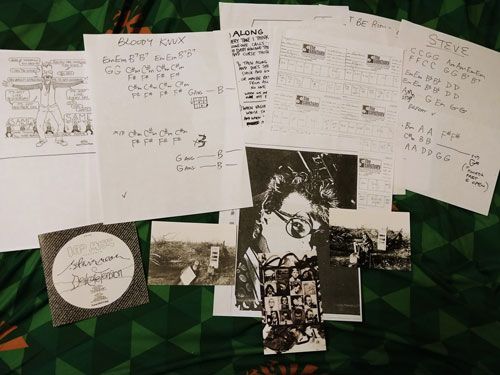
(Image credit: Flickr user UT Connewitz Photo Crew)
Neatorama is proud to bring you a post by David Buck, courtesy of Ernie Smith of Tedium, a twice-weekly newsletter that hunts for the end of the long tail. In another life, he ran ShortFormBlog.
The tale of R. Stevie Moore, perhaps the most prolific musician that the world has ever seen. So why haven’t you heard of him?
Many great artists exist outside the mainstream. All it takes is a keen ear, an open mind and taste for variety to find a few unique artists or songs one would never hear on the radio or otherwise be exposed to. One of my favorite musicians of all time is Robert Steven Moore, whom I have had the great fortune to not only hear (and own) his wonderful music, but also to have spoken with him—albeit briefly—on several occasions. Some people may feel overwhelmed at the sheer quantity of his work and at a loss for a starting point. Fortunately, I’m here to help.
100 vinyl copies of R. Stevie Moore’s first official album, Phonography, were originally distributed in 1976. One of those copies was rumored to have been owned by Frank Zappa, a noted champion of outsider artists who helped to bring The Shaggs, Wildman Fischer and other musicians to popular attention. This is, of course, apocryphal, but it’s a neat idea and—given Zappa’s musical interests—makes perfect sense. While Zappa’s own unique brand of composition spread over 60 albums during his lifetime and over 100 albums posthumously, that number is dwarfed by Moore’s catalog in sheer quantity.
Moore has released more than 400 albums—either by himself or through a label—over the past 50 years.Who is R. Stevie Moore (and Why Isn’t Anybody Talking About Him?)
“You know a lot about my career,” Moore told me during a conversation we had recently.
We were discussing the various record labels his “official” albums have been on: Cordelia Records, New Rose, HP Records, Hamster, etc.… and I suppose that’s true; it’s my inner music nerd rising to the surface. If we put that in the context of my youth spent listening to as many episodes of The Dr. Demento Show as possible and meticulously curating a collection of comedy, novelty, and outsider albums, it makes sense.
I first heard about Moore via The Dr. Demento Show. I don’t think I would’ve discovered his music otherwise. Sure, I sometimes come across great artists by happy accident—for instance, I discovered Jonathan Coulton from an old YouTube video—but Dr. D was truly the catalyst for my decision to seek out Moore’s work.
R. Stevie Moore was born on January 18, 1952. He grew up in Madison, TN. His father, Bob Moore, was the bass player for established acts such as Cowboy Copa, Johnny Cash, Roy Orbison, and Elvis Presley. Moore eventually became interested in music and began making his own homemade reel-to-reel tapes. He would then send these tapes to New Jersey, into the welcoming hands of his uncle Harry Palmer. Palmer put together his favorite tracks from Moore’s reels to create the Phonography album.
During this time, he recorded several albums, including R. Stevie Moore Reforms the Beatles, an all-instrumental album of Beatles cover songs. Moore moved to New Jersey in 1978, got a job at Sam Goody and continued recording his wonderful, sonic experiments. Moore constantly recorded albums at home and was worked on making contacts in the music world, doing occasional performances, and appearing on public access shows—notably, The Uncle Floyd Show and The Scott and Gary Show.
In 1984, Moore’s friend Patrick Mathe released a compilation of the musician’s work on his record label, New Rose. Dubbed Everything You Ever Wanted to Know About R. Stevie Moore but We’re Afraid to Ask, it was the first of several New Rose albums.
Glad Music, Teenage Spectacular, and Warning followed. Another album, What’s the Point? was also released in 1984 on Cuneiform Records, that label’s first release. Like Zappa, the prolific Moore spent years meticulously recording, releasing, archiving, and cataloging his work. Unlike Zappa, Moore’s work is criminally neglected and relatively unknown, but well worth checking out. As Moore sardonically points out in the lead track from his Delicate Tension, he’s a cool daddio: a man busy making music while everyone else does whatever it is they do.
Through his “underground” career and do-it-yourself aesthetic, Moore would go on to receive acclaim for his work in several important music journals throughout the 70s and 80s, namely Trouser Press, but never seemed to attain the level of fame other, less prolific and dedicated artists had.
There are approximately 400 albums in R. Stevie Moore’s discography, sound recordings and albums released between 1968 and 2017. In fact, he released two new albums during the writing of this article. The “400 albums” figure is derived from the entirety of his output, including his homemade Cassette Club releases and his officially released LPs/CDs. For the uninitiated, the arduous task of simply selecting an entry point can be daunting, so we’ve taken the time to curate a list of our favorites to help the new listener.

A…
The post The Man with 400 Albums appeared first on FeedBox.